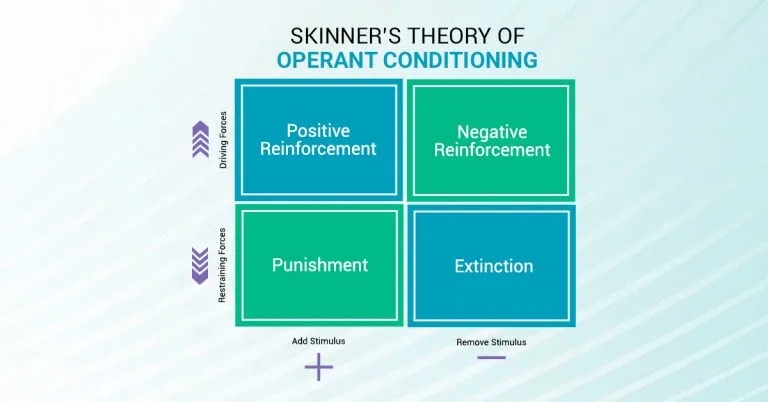Skinner’s Theory of Operant Conditioning: A Key to Effective Learning
Behavioral psychology has played a significant role in shaping modern learning strategies. One of the most influential theories in this domain is B.F. Skinner’s Operant Conditioning Theory, which explains how behaviors are learned and modified through reinforcement and punishment. This theory has vast applications in education, workplace training, microlearning, and even gamification.
In this article, we will explore Skinner’s theory, its key principles, real-world applications, and how it enhances learning experiences—especially in today’s digital age.
Understanding Skinner’s Operant Conditioning Theory
B.F. Skinner, an American psychologist and behaviorist, developed Operant Conditioning as an extension of the classical conditioning principles introduced by Ivan Pavlov. Unlike Pavlov’s work, which focused on involuntary responses, Skinner’s theory emphasizes voluntary behaviors and how they can be shaped through reinforcement or punishment.
At its core, Operant Conditioning revolves around the consequences of behavior. Skinner proposed that behavior is strengthened if followed by positive consequences (reinforcement) and weakened if followed by negative consequences (punishment). He tested these principles through experiments using his famous Skinner Box, where animals learned to perform tasks in exchange for rewards or to avoid punishments.
The Key Principles of Operant Conditioning
Skinner’s theory is built on four main components:
1. Positive Reinforcement
This occurs when a behavior is strengthened by adding a desirable stimulus after it happens. For example:
- A student receives praise or a reward for completing an assignment on time, encouraging them to continue meeting deadlines.
- In workplace training, employees earn points or badges for completing learning modules, reinforcing continuous learning.
2. Negative Reinforcement
Here, behavior is strengthened by removing an unpleasant stimulus. For example:
- A manager reduces micromanagement for employees who consistently meet their goals, reinforcing independent work.
- In gamified learning, removing repetitive tasks after a learner demonstrates mastery encourages further engagement.
3. Positive Punishment
This involves adding an unfavorable consequence to discourage a behavior. For example:
- An employee who consistently misses deadlines receives formal feedback, discouraging future delays.
- In an educational setting, a student gets extra assignments for not following class rules, discouraging disruptive behavior.
4. Negative Punishment
This happens when a behavior is weakened by removing a desirable stimulus. For example:
- A team member loses access to a project after missing multiple deadlines, discouraging poor time management.
- A child loses screen time privileges after refusing to do homework, encouraging timely completion in the future.
Real-World Applications of Operant Conditioning
1. Education and Training
Skinner’s principles are widely used in classrooms and corporate training programs. Teachers and trainers use reinforcement strategies to encourage participation and improve retention. For example:
- Gamification in e-learning: Learners receive badges, points, or certificates for completing training modules.
- Personalized feedback: Instant feedback helps learners adjust their behavior and improve performance.
- AI-powered microlearning: Platforms like MaxLearn use adaptive learning to reinforce knowledge based on individual progress.
2. Workplace Learning and Employee Training
Organizations apply Operant Conditioning to shape employee behavior, boost productivity, and improve compliance training.
- Performance-based incentives: Employees receive bonuses or promotions for meeting performance targets (positive reinforcement).
- Progressive discipline: Repeated policy violations may lead to formal warnings or job loss (negative punishment).
- Learning management systems (LMS) with gamification: Employees engage more in training when rewarded with interactive learning experiences.
3. Customer Behavior and Marketing
Marketers and businesses leverage reinforcement strategies to influence consumer behavior.
- Loyalty programs: Customers earn rewards or discounts for frequent purchases (positive reinforcement).
- Limited-time offers: Creating urgency encourages faster decision-making and purchases (negative reinforcement).
- Subscription penalties: Extra charges for late payments discourage late bill payments (positive punishment).
4. Parenting and Child Development
Operant Conditioning is commonly used to shape children’s behavior.
- Rewarding good behavior: A child receives praise or extra playtime for completing homework on time (positive reinforcement).
- Time-outs for misbehavior: Removing playtime privileges discourages tantrums (negative punishment).
How Microlearning and Gamification Enhance Operant Conditioning
Modern e-learning and training platforms integrate Skinner’s principles through microlearning platform and gamification strategies. These techniques ensure learners remain engaged, motivated, and retain knowledge effectively.
1. Reinforcement Through Microlearning
Microlearning breaks down information into bite-sized lessons, making reinforcement easier. By using AI-powered personalized learning, platforms like MaxLearn ensure that learners receive content tailored to their needs, reinforcing learning at the right moments.
- Spaced repetition: Revisiting key concepts over time strengthens memory.
- Instant feedback: Learners know immediately if they are correct, reinforcing correct answers.
- AI-driven adaptive learning: Content is adjusted based on past performance to reinforce weak areas.
2. Gamification for Positive Reinforcement
Gamification applies operant conditioning principles by rewarding learners for achievements.
- Points, badges, leaderboards: Learners feel motivated to complete tasks.
- Unlockable content: Completing one module unlocks the next, reinforcing progress.
- Social recognition: Competing with peers encourages continuous improvement.
These techniques make learning more engaging and effective, preventing knowledge loss and improving long-term retention.
Criticisms and Limitations of Operant Conditioning
Despite its success, Operant Conditioning has limitations:
- Does not consider internal motivation – It focuses mainly on external rewards rather than intrinsic motivation.
- Over-reliance on rewards – If rewards are removed, behaviors might stop (extinction effect).
- Ethical concerns in punishment – Excessive punishment can lead to fear and resentment rather than learning.
To address these, blended learning approaches integrate cognitive and behavioral theories for a well-rounded education experience.
Final Thoughts: Why Skinner’s Theory is Still Relevant Today
Skinner’s Operant Conditioning Theory remains one of the most impactful behavioral learning theories. Its applications in education, workplace training, marketing, and parenting show how reinforcement and punishment shape behaviors effectively.
Modern e-learning platforms, like MaxLearn, leverage these principles through AI-driven microlearning and gamification, ensuring effective knowledge retention and learner engagement. By applying the right reinforcement strategies, businesses and educators can create better learning experiences that lead to long-term behavioral change and improved performance.
Are you ready to implement Skinner’s principles in your training strategy? Explore how MaxLearn’s AI-powered microlearning platform can enhance learning engagement and effectiveness today!
